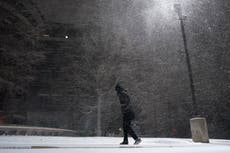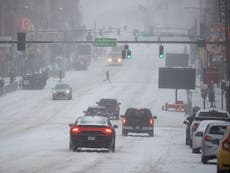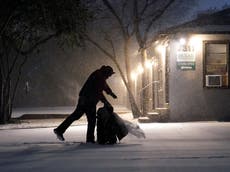Tucker Carlson blames green energy for Texas storm
Are frozen wind turbines to blame for Texas power outages?
More than 4.2 million people left without power following winter storm
Graeme Massie Los Angeles@graemekmassie
Green energy sources are not to blame for the winter storm Uri power blackouts in Texas, experts say.
More than 4.2 million people were left without power after a rare cold front brought record-breaking freezing conditions to the state
Fox News host Tucker Carlson, among others, has tried to point the finger at renewable energy sources such as wind turbines for the rolling blackouts seen in the state.
“So it was all working great until the day it got cold outside. The windmills failed like the silly fashion accessories they are, and people in Texas died,” said Carlson on his Monday show.
Texas Governor Greg Abbott has called for the state legislature to investigate the Electric Reliability Council of Texas, which manages the flow of 75 per cent of power in the state.
The grid operators said that nearly half of all wind power generators had gone offline because of the unusually moist winter conditions.
But experts have been quick to say that the freezing-up of wind turbines in the state is not the main reason why many areas have been thrown into darkness.
ERCOT acknowledges that frozen wind turbines have played a role, but that frozen instruments at natural gas, coal and nuclear facilities and a limited supply of natural gas are the main factors
“We’ve had some issues with pretty much every kind of generating capacity in the course of this multi-day event,” said ERCOT’s Dan Woodfin.
Wind shutdowns during the current crisis accounted for 3.6 to 4.5 gigawatts of energy, or less than 13 per cent of the 30 to 35 gigawatts of total outage, Mr Woodfin told Bloomberg.
At this time of year wind only accounts for 25 per cent of the energy generated in Texas, which rises to 60 per cent during other periods.
“The performance of wind and solar is way down the list among the smaller factors in the disaster that we’re facing,” Daniel Cohan, associate professor of environmental engineering at Rice University, told Bloomberg.
Experts say that the main issue is that the power grid is simply not built to sustain the current load being placed upon it during the bad weather.
“Grid demand is so much higher than we’ve really built the system for in the wintertime,” said Joshua Rhodes, a research associate at the University of Texas at Austin.
“No one’s model of the power system envisioned that all 254 Texas counties would come under a winter storm warning at the same time.
“It’s putting major strain on both the electricity grid and the gas grid that feeds both electricity and heat.”
And experts say that wildly fluctuating weather brought on by the climate crisis will cause increasing problems as the systems only work if operators can reliably predict future dangers.
And the more unpredictable the weather the more stress will be placed on the grids, experts tell the New York Times.
Are frozen wind turbines to blame for Texas power outages?
More than 4.2 million people left without power following winter storm
Graeme Massie Los Angeles@graemekmassie
Green energy sources are not to blame for the winter storm Uri power blackouts in Texas, experts say.
More than 4.2 million people were left without power after a rare cold front brought record-breaking freezing conditions to the state
Fox News host Tucker Carlson, among others, has tried to point the finger at renewable energy sources such as wind turbines for the rolling blackouts seen in the state.
“So it was all working great until the day it got cold outside. The windmills failed like the silly fashion accessories they are, and people in Texas died,” said Carlson on his Monday show.
Texas Governor Greg Abbott has called for the state legislature to investigate the Electric Reliability Council of Texas, which manages the flow of 75 per cent of power in the state.
The grid operators said that nearly half of all wind power generators had gone offline because of the unusually moist winter conditions.
But experts have been quick to say that the freezing-up of wind turbines in the state is not the main reason why many areas have been thrown into darkness.
ERCOT acknowledges that frozen wind turbines have played a role, but that frozen instruments at natural gas, coal and nuclear facilities and a limited supply of natural gas are the main factors
“We’ve had some issues with pretty much every kind of generating capacity in the course of this multi-day event,” said ERCOT’s Dan Woodfin.
Wind shutdowns during the current crisis accounted for 3.6 to 4.5 gigawatts of energy, or less than 13 per cent of the 30 to 35 gigawatts of total outage, Mr Woodfin told Bloomberg.
At this time of year wind only accounts for 25 per cent of the energy generated in Texas, which rises to 60 per cent during other periods.
“The performance of wind and solar is way down the list among the smaller factors in the disaster that we’re facing,” Daniel Cohan, associate professor of environmental engineering at Rice University, told Bloomberg.
Experts say that the main issue is that the power grid is simply not built to sustain the current load being placed upon it during the bad weather.
“Grid demand is so much higher than we’ve really built the system for in the wintertime,” said Joshua Rhodes, a research associate at the University of Texas at Austin.
“No one’s model of the power system envisioned that all 254 Texas counties would come under a winter storm warning at the same time.
“It’s putting major strain on both the electricity grid and the gas grid that feeds both electricity and heat.”
And experts say that wildly fluctuating weather brought on by the climate crisis will cause increasing problems as the systems only work if operators can reliably predict future dangers.
And the more unpredictable the weather the more stress will be placed on the grids, experts tell the New York Times.
“It’s essentially a question of how much insurance you want to buy,” Jesse Jenkins, an energy systems engineer at Princeton University, told the newspaper.“What makes this problem even harder is that we’re now in a world where, especially with climate change, the past is no longer a good guide to the future. We have to get much better at preparing for the unexpected.”
No, frozen wind turbines aren't the main culprit for Texas' power outages
By ERIN DOUGLAS AND ROSS RAMSEY, TEXAS TRIBUNE
Frozen wind turbines in Texas caused some conservative state politicians to declare Tuesday that the state was relying too much on renewable energy. But in reality, the lost wind power makes up only a fraction of the reduction in power-generating capacity that has brought outages to millions of Texans across the state during a major winter storm.
An official with the Electric Reliability Council of Texas said Tuesday afternoon that 16 gigawatts of renewable energy generation, mostly wind generation, was offline. Nearly double that, 30 gigawatts, had been lost from thermal sources, which includes gas, coal and nuclear energy.
"Texas is a gas state," said Michael Webber, an energy resources professor at the University of Texas at Austin.
While Webber said all of Texas' energy sources share blame for the power crisis, the natural gas industry is most notably producing significantly less power than normal.
"Gas is failing in the most spectacular fashion right now," Webber said.
Dan Woodfin, a senior director at ERCOT, echoed that sentiment Tuesday.
"It appears that a lot of the generation that has gone offline today has been primarily due to issues on the natural gas system," he said during a Tuesday call with reporters.
Still, some have focused their blame on wind power.
"This is what happens when you force the grid to rely in part on wind as a power source," U.S. Rep. Dan Crenshaw, R-Houston, tweeted Tuesday afternoon. "When weather conditions get bad as they did this week, intermittent renewable energy like wind isn't there when you need it."
He went on to note the shutdown of a nuclear reactor in Bay City because of the cold, and finally got to what energy experts say is the biggest culprit, "Low Supply of Natural Gas: ERCOT planned on 67GW from natural gas/coal, but could only get 43GW of it online. We didn't run out of natural gas, but we ran out of the ability to get natural gas. Pipelines in Texas don't use cold insulation -so things were freezing."
Agriculture Commissioner Sid Miller, known for his right-wing Facebook posts that have, in the past, spread misinformation and amplified conspiracy theories, also posted an unvarnished view of wind energy on Facebook: "We should never build another wind turbine in Texas."
In another post, Miller was even more forthright, but also misleading, "Insult added to injury: Those ugly wind turbines out there are among the main reasons we are experiencing electricity blackouts. Isn't that ironic? ... So much for the unsightly and unproductive, energy-robbing Obama Monuments. At least they show us where idiots live."
While wind power skeptics claimed the week's freeze means wind power can't be relied upon, wind turbines - like natural gas plants - can be "winterized" or modified to operate during very low temperatures. Experts say that many of Texas' power generators have not made those investments necessary to prevent disruptions to equipment since the state does not regularly experience extreme winter storms.
It's estimated that of the grid's total winter capacity, about 80% of it, or 67 gigawatts, could be generated by natural gas, coal and some nuclear power. Only 7% of ERCOT's forecasted winter capacity, or six gigawatts, was expected to come from various wind power sources across the state.
Production of natural gas in the state has plunged due to the freezing conditions, making it difficult for power plants to get the fuel necessary to run the plants. Natural gas power plants usually don't have very much fuel storage on site, experts said. Instead, the plants rely on the constant flow of natural gas from pipelines that run across the state from areas like the oil and natural gas producing Permian Basin in West Texas, to major demand centers like Houston and Dallas.
Gov. Greg Abbott specified that fossil fuel sources were contributing to the problems with the grid when describing the situation Monday afternoon.
"The ability of some companies that generate the power has been frozen. This includes the natural gas & coal generators," he wrote in a tweet.
Heather Zichal, CEO of the industry group the American Clean Power Association, said opponents of renewable energy were trying to distract from the failures elsewhere in the system and slow the "transition to a clean energy future."
"It is disgraceful to see the longtime antagonists of clean power - who attack it whether it is raining, snowing or the sun is shining - engaging in a politically opportunistic charade misleading Americans to promote an agenda that has nothing to do with restoring power to Texas communities," she said.
The Texas Tribune is a nonprofit, nonpartisan media organization that informs Texans - and engages with them - about public policy, politics, government and statewide issue.
By ERIN DOUGLAS AND ROSS RAMSEY, TEXAS TRIBUNE
Tuesday, February 16, 2021 9:14PM
Frozen wind turbines in Texas caused some conservative state politicians to declare Tuesday that the state was relying too much on renewable energy. But in reality, the lost wind power makes up only a fraction of the reduction in power-generating capacity that has brought outages to millions of Texans across the state during a major winter storm.
An official with the Electric Reliability Council of Texas said Tuesday afternoon that 16 gigawatts of renewable energy generation, mostly wind generation, was offline. Nearly double that, 30 gigawatts, had been lost from thermal sources, which includes gas, coal and nuclear energy.
"Texas is a gas state," said Michael Webber, an energy resources professor at the University of Texas at Austin.
While Webber said all of Texas' energy sources share blame for the power crisis, the natural gas industry is most notably producing significantly less power than normal.
"Gas is failing in the most spectacular fashion right now," Webber said.
Dan Woodfin, a senior director at ERCOT, echoed that sentiment Tuesday.
"It appears that a lot of the generation that has gone offline today has been primarily due to issues on the natural gas system," he said during a Tuesday call with reporters.
VIDEO
Still, some have focused their blame on wind power.
"This is what happens when you force the grid to rely in part on wind as a power source," U.S. Rep. Dan Crenshaw, R-Houston, tweeted Tuesday afternoon. "When weather conditions get bad as they did this week, intermittent renewable energy like wind isn't there when you need it."
He went on to note the shutdown of a nuclear reactor in Bay City because of the cold, and finally got to what energy experts say is the biggest culprit, "Low Supply of Natural Gas: ERCOT planned on 67GW from natural gas/coal, but could only get 43GW of it online. We didn't run out of natural gas, but we ran out of the ability to get natural gas. Pipelines in Texas don't use cold insulation -so things were freezing."
Agriculture Commissioner Sid Miller, known for his right-wing Facebook posts that have, in the past, spread misinformation and amplified conspiracy theories, also posted an unvarnished view of wind energy on Facebook: "We should never build another wind turbine in Texas."
In another post, Miller was even more forthright, but also misleading, "Insult added to injury: Those ugly wind turbines out there are among the main reasons we are experiencing electricity blackouts. Isn't that ironic? ... So much for the unsightly and unproductive, energy-robbing Obama Monuments. At least they show us where idiots live."
While wind power skeptics claimed the week's freeze means wind power can't be relied upon, wind turbines - like natural gas plants - can be "winterized" or modified to operate during very low temperatures. Experts say that many of Texas' power generators have not made those investments necessary to prevent disruptions to equipment since the state does not regularly experience extreme winter storms.
It's estimated that of the grid's total winter capacity, about 80% of it, or 67 gigawatts, could be generated by natural gas, coal and some nuclear power. Only 7% of ERCOT's forecasted winter capacity, or six gigawatts, was expected to come from various wind power sources across the state.
Production of natural gas in the state has plunged due to the freezing conditions, making it difficult for power plants to get the fuel necessary to run the plants. Natural gas power plants usually don't have very much fuel storage on site, experts said. Instead, the plants rely on the constant flow of natural gas from pipelines that run across the state from areas like the oil and natural gas producing Permian Basin in West Texas, to major demand centers like Houston and Dallas.
Gov. Greg Abbott specified that fossil fuel sources were contributing to the problems with the grid when describing the situation Monday afternoon.
"The ability of some companies that generate the power has been frozen. This includes the natural gas & coal generators," he wrote in a tweet.
Heather Zichal, CEO of the industry group the American Clean Power Association, said opponents of renewable energy were trying to distract from the failures elsewhere in the system and slow the "transition to a clean energy future."
"It is disgraceful to see the longtime antagonists of clean power - who attack it whether it is raining, snowing or the sun is shining - engaging in a politically opportunistic charade misleading Americans to promote an agenda that has nothing to do with restoring power to Texas communities," she said.
The Texas Tribune is a nonprofit, nonpartisan media organization that informs Texans - and engages with them - about public policy, politics, government and statewide issue.
Texas weather - live: Record-breaking winter storm Uri sparks power crisis for millions and leaves 25 dead




No comments:
Post a Comment